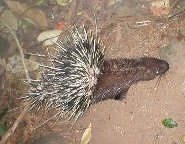 The Malayan porcupine (Hystrix brachyura) is a rare and elusive creature that lives in many areas of Asia including but not limited to India, Malaysia, Nepal, and Vietnam. They are found living in altitudes from sea level to approximately 1,300 meters above sea level. With a usual life span of 20-27 years depending on environmental and encroaching human building and population factors, they can weigh from 1.7 pounds (0.760 Kg) to around 5.4 pounds (2.414 Kg) and can reach a length of 83.5 cm (32.9 inches) including their long tails. These animals are very shy and prefer to wander and forage for food at night. They are predominantly nocturnal and are rarely seen for any reason during the day unless threatened or sick.
The Malayan porcupine (Hystrix brachyura) is a rare and elusive creature that lives in many areas of Asia including but not limited to India, Malaysia, Nepal, and Vietnam. They are found living in altitudes from sea level to approximately 1,300 meters above sea level. With a usual life span of 20-27 years depending on environmental and encroaching human building and population factors, they can weigh from 1.7 pounds (0.760 Kg) to around 5.4 pounds (2.414 Kg) and can reach a length of 83.5 cm (32.9 inches) including their long tails. These animals are very shy and prefer to wander and forage for food at night. They are predominantly nocturnal and are rarely seen for any reason during the day unless threatened or sick.With a huge habitat range of nearly the entire continent of Asia and even further into neighboring continents, the Malayan porcupine is one of the most widely yet sparsely spread out rodents on Earth. What makes the habitat of these creatures unique, however, is the type of terrain that they live in. They live in heavily wooded areas and make their dens in rocky areas of the ground. Malayan porcupines create burrows which lead into huge networks of tunnels beneath their surrounding habitats, allowing them to get around during the daytime without being exposed to sunlight.
The Malayan porcupine is covered at birth with soft quills which sharpen into rigid, hard quills upon reaching adulthood. This is the animal's defense mechanism and is effective to most predators and hunters that come after these porcupines. Though not predators themselves, they eat fruits, roots, nuts, and insects, as well as carrion (or dead animal matter).
In general, the Malayan porcupine is endangered because of over-hunting and human overpopulation into their habitats. There are tribes of people who eat them and who use their quills for decorative purposes. They are also hunted by feral cats, some types of wild hogs, and other predatory animals that live in the same region as they do. In some countries like Vietnam, their paws are considered good-luck charms just as rabbits' feet are in the United States. Without a little consideration and help from mankind, this unique species will become extinct very quickly. The International Union for Conservation of Nature ranks the Malayan porcupine as a vulnerable species with a high likelihood of facing extinction in the wild. This is due to the fact that they are hunted for their meat. They are also hunted to be displayed as decoration for their unique quills and coloring.
The Malayan porcupine is listed as Vulnerable (VU), considered to be facing a high risk of extinction in the wild, on the IUCN Red List of Threatened Species
Namings for the Malayan porcupine
A young / baby of a Malayan porcupine is called a 'pup'. The females are called 'sow' and males 'boar'. A Malayan porcupine group is called a 'prickle or family'.Countries
Burma, Cambodia, China, India, Indonesia, Laos, Malaysia, Nepal, Singapore, Thailand and VietnamSome facts about the
Old World porcupine
Adult weight : 8 kg (17.6 lbs)
Maximum longevity : 27 years
Gestation : 112 days
Litter size : 2
Weight at birth : 0.445 kg (0.979 lbs)

Custom Search